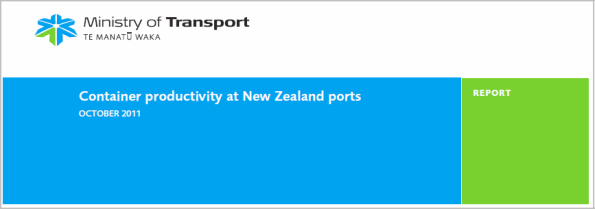Lies, Boards, and Aucklandports (#Wha)
|
|
POAL management met with maritime workers and their union reps in Len Brown’s office yesterday, with the mayor mediating. The meeting lasted supposedly for three hours – after which the protagonists emerged.
POAL announced no change in their position; the sackings of 292 port workers would not be rescinded and casualisation and contracting out would proceed as planned.
POAL Board chairman, Pearson stated emphatically,
“The collective negotiations are over. We’re now into implementing the decision. The contractors have already been engaged and they are recruiting.
“Where I feel the mayor could help in the mediation is to try and get the staff that are out on strike to apply for jobs with the contractors because we understand that there’s a sinister element in the union that’s preventing the individual employees to make that decision.” – Radio NZ
Pearson’s melodramatic reference to “a sinister element in the union ” would be laughable, if 292 families were not impacted by POAL’s intransigence,
|
|
POAL management’s intransigence could be egoism at work from Broad Chairman Richard Pearson and CEO Tony Gibson – except there is much more to it than that.
POAL have consistantly stated that the casualisation and contracting out of their workforce was predicated on the port performing badly and needing to improve it’s comopetiveness. As port CEO Tony Gibson said,
“We’ve weighed up all the options and we believe this is the best decision for the future of the Port. Auckland enjoys significant natural advantages, including its proximity to New Zealand’s largest market, where 60% of exports, and 70% of import business takes place. Until now we have been constrained by practices which have reduced the Port’s competitiveness, and in recent months industrial action, which has lost us significant business.”
POAL Board chairman Richard Pearson said on TVNZ’s Q+A,
“Well, from my perspective, Paul, I came into this situation, and I’ve been 37 years in the container port business and ports all around the world. I have never seen such a waste of resource going on here. I have never seen a situation where you pay someone for 43 hours and they work 26. I’ve never seen a situation where ships wait to come in to start waiting for the start of a shift. You know, that’s like aeroplanes flying around waiting for-”
“Paul, Australasia’s not the benchmark for good container-port operations around the world, with all due respect, okay? As I’ve said to you, I have never seen such a potential asset like we’ve got at Auckland that could actually run better... [abridged] ” – Ibid
“Paul, we’ve got them going. They’re working. 25 years Tauranga’s been working on this model, and it’s been working well. And during that time, we’ve lost 12% of our market to Tauranga. We can’t wait. We have to make this change now, and we have to make it quickly. ” – Ibid
POAL’s webpage, “Questions & Answers: Changes at Ports of Auckland“, puts great emphasis on increased productivity and competitiveness.
Gibson and Pearson seem to be alarmed – almost in panic – at POAL’s ‘lack of productivity’.
Which is curious.
Because recent official government reports paint a completely different picture,
|
|
The report states, in part,
“New Zealand ports had differing results in 2009 and 2010, reflecting the differing situations for each
port. Tauranga performed well for crane, ship and vessel rates, while Auckland and Otago had vessel
rates comparable with Tauranga. The trends over the last two calendar years show that crane rates at
New Zealand ports on average have been static, but ship and vessel rates on average have grown
about four percent per annum. The container productivity of New Zealand ports appears at least
comparable with, and in some cases better than, Australian and other international ports.”
“Auckland and Otago’s vessel rates are relatively higher than their crane rates. Container
terminal productivity tends to be higher when a ship loads and unloads more containers.
These ports have had regular calls from larger container ships (that is, ships with capacity for
4,100 containers). Consequently, these ports tend to use relatively more crane time4 than
other ports to load and unload containers from ships.”
“Comparisons with Australian ports
Table 3 below compares New Zealand and Australian ports in 2010. Table 4 below compares
trends over 2009 and 2010 for national-average crane, ship and vessel rates. Some
conclusions are as follows.
• The national-average crane rate for New Zealand ports is slightly behind the nationalaverage
for Australian ports.
• The national-average ship and vessel rates for New Zealand ports are ahead of the
national-average for Australian ports.
• Crane rates in both countries are largely unchanged over the period.
• Ship and vessel rates in both countries are increasing (average growth rates in both
countries are about four percent per annum). The growth appears to be due to ports
using relatively more crane time than in previous years. This may be related to the
average size of container ships increasing in recent years.
• Comparing across all these ports, there is no apparent evidence that productivity
increases with larger total volumes of containers at ports (‘economies of scale’).”
|
|
“Conclusions
There is a mixture of container productivity results for New Zealand’s six main container ports,
reflecting the differing situations for each port. Overall, the top three container operations
appear to be Auckland, Tauranga and Otago. The trend over the last two years is for national average
crane productivity to be static, but national-average ship and vessel productivity to
grow about four percent per annum. This growth seems to be due to ports using relatively
more crane time than in previous years, which may be related to an increasing average size
of container ships.”
Just to emphasise the point; “Overall, the top three container operations
Which – yet again – shows up POAL management to be somewhat ‘loose‘ with the truth.
One cannot but help come to the conclusion that Ports of Auckland is a reasonably efficient operation.
Profit-wise, it is also performing well, judging by NBR reports,
|
Imports drive Ports of Auckland profit higher
|
Increased traffic at Ports of Auckland
|
Ports of Auckland profits hold steady
|
Instead, it appears that the agenda to destroy the union and impose casualisation is a deliberate plan to drive down wages. It seems to be a response to Auckland City Council’s demand to increase their rate of return from 6% to 12%. As Len Brown said on TVNZ’s Q+A on 11 March,
|
“PAUL Well, how firm are you on this? Have you laid down the law on the 12%?
LEN We have given it to them in our statement of corporate intent. Right at the start of the year, I went down to the port, met all the workers and the employees and the company directors down there and said, ‘Right, this is what we’re expecting from the port.’ And we had an hour’s Q & A-
PAUL This is what we’re expecting. Is this-? I mean, were you laying the law about the return you want in five years – 12%?
LEN We were laying down the law in terms of what we expected from the port in terms of its return and in terms of its performance generally.PAUL Where did you get the 12%?
LEN So, the 12% was an estimate, a view that certainly I’ve been working on for right through the last sort of 18 months, two years. It was view that was discussed our own table with the officers, with our own council-
PAUL So it’s a guess? It’s a good guess?LEN No, it’s an estimate.
PAUL (laughs)
LEN This is what we think we should be aiming to achieve. And so we went back to the company and said, ‘Okay, this where we think you should be. What is your advice back to us?’ Their advice was, ‘Give us five years and we believe that we can receive that.’PAUL Well, excuse me, look at this. Okay, 12%, that’s your estimate – guesstimate. Tauranga returns 6.8%, Lyttelton 8.6%, Sydney 6.7%, Melbourne 3.1%, Auckland 6% — 6.3% after tax.
LEN So not just about return either-
PAUL Where’s the 12% being made anywhere?LEN It’s about competitiveness against other ports. So we are losing share against Tauranga. We are competing flat out against Brisbane, in particular, and Sydney. It was our desire that we wanted the port to be much much stronger in terms of its– “
|
So there we have it. The drive for greater profit.
Paid for out of the wages of ordinary workers.
Does this seem remotely fair to anyone? (ACT supporters need not respond to this question.)
|
On the social networking ‘battlefront’, supporters of POAL have set up their own Facebook page,
|
|
Meanwhile, POAL (Ports of Auckland Ltd) continues to waste ratepayers’ money on full-page and half-page ads in our daily newspapers.
This propaganda piece appeared in the Business Section of the NZ Herald today,
|
|
By “sheer coincidence” the ad was placed opposite an advertisement appealing to port workers to abandon the picket line and contact either of the two recruiting companies.
This is not just a gross mis-use of company funds – it is an abuse of economic power. This is a clear example of why trade unions are still very much a necessity.
With trade unions to monitor workers’ rights and conditions, companies are able to wield considerable power in any dispute.
(Acknowledgement to Cathy Casey.)
Interestingly, POAL states on their website that “We do not have any vacancies at the Ports of Auckland at this stage“,
|
|
292 port workers would be happy to hear that.
|
*** Update ***
Union seeks injunction to halt wharfie dismissals
|
|












Too much talk about the financial returns to the Ports of Auckland. Ratepayers own the Ports of Auckland – the council and its company just manage the POA.
12% certainly seems an unrealistic figure, Peter. Evidently, no port in Australasia achieves that reeturn on investment.
But I get what you mean. POAL and (many in) the Council seem to have lost sight of 292 men, and their families.
This isn’t the “invisible hand” of the free market – this is the cold, dead grasp of that “free” market.